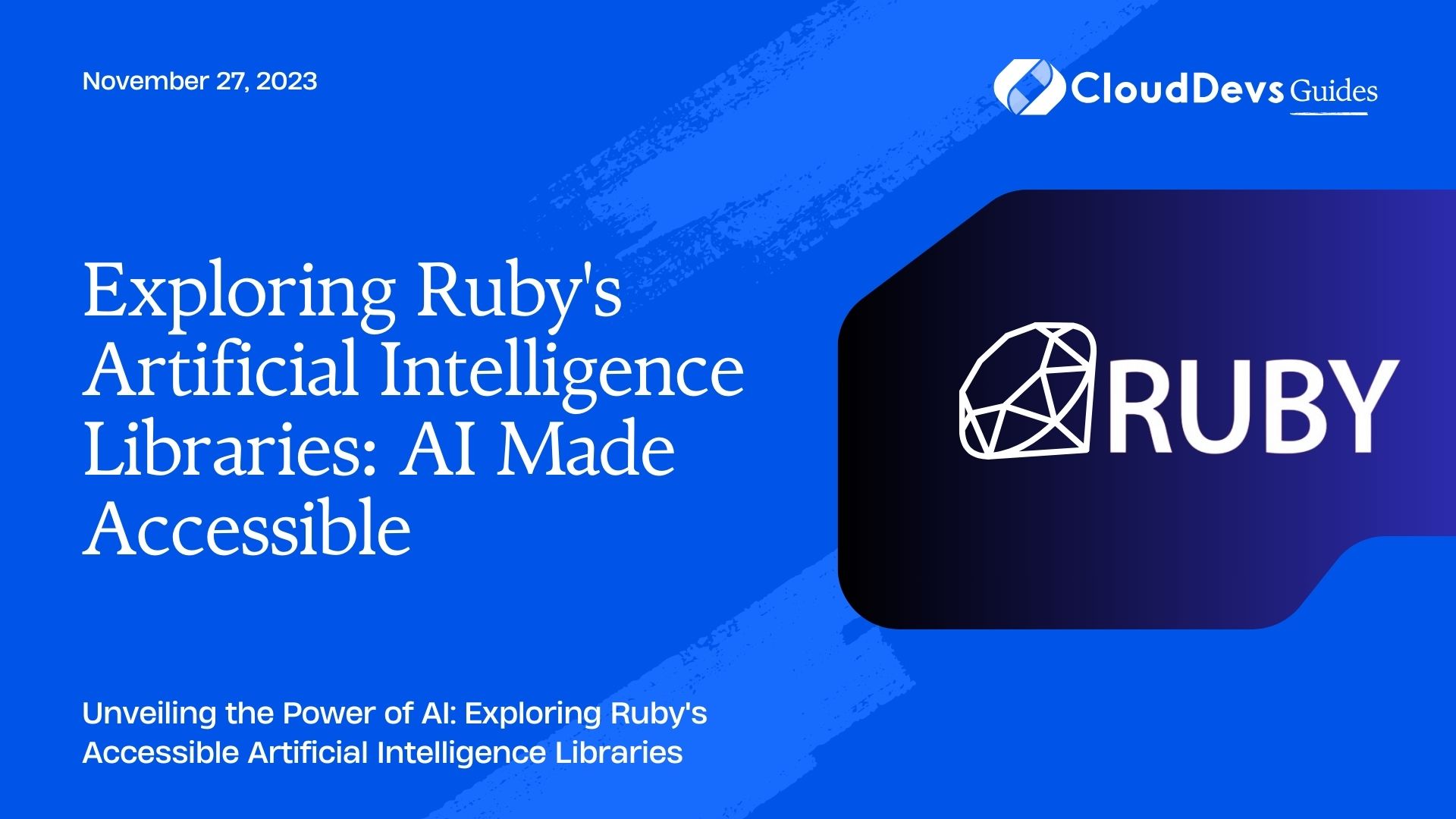Exploring Ruby’s Artificial Intelligence Libraries: AI Made Accessible
In the realm of technology, artificial intelligence (AI) has emerged as a transformative force, revolutionizing industries and enhancing various aspects of our lives. While AI might sound complex and intimidating, Ruby, a dynamic and user-friendly programming language, has paved the way for making AI accessible to a wider audience. In this blog, we’ll embark on a journey to explore Ruby’s artificial intelligence libraries, demonstrating how they empower developers to create intelligent applications without the steep learning curve.
Table of Contents
1. Why Ruby for AI?
Ruby has always been favored by developers for its elegant and human-readable syntax. But can it really stand up to the challenges of AI development? The answer is a resounding yes. Ruby offers several libraries that provide a bridge to the world of AI, allowing developers to harness its power without delving too deeply into the intricacies of AI algorithms. Let’s delve into some of the most popular AI libraries that make Ruby an excellent choice for AI development.
1.1. AI4R: Artificial Intelligence for Ruby
AI4R is an open-source Ruby library that provides various machine learning algorithms and tools, making it a fantastic starting point for AI enthusiasts. Whether you’re exploring data mining, neural networks, or genetic algorithms, AI4R has got you covered. Let’s look at a simple example of how to use the k-means clustering algorithm from AI4R:
ruby
require 'ai4r'
data_set = Ai4r::Data::DataSet.new(data: [[1, 2], [2, 3], [8, 7], [10, 9]])
kmeans = Ai4r::Clusterers::KMeans.new
kmeans.build(data_set, 2) # 2 clusters
puts "Cluster centers: #{kmeans.centroids}"
data_set.data_items.each do |item|
puts "Item #{item} belongs to cluster #{kmeans.eval(item)}"
end
With AI4R, you can effortlessly incorporate machine learning algorithms into your Ruby projects, opening doors to predictive analytics, pattern recognition, and more.
1.2. TensorStream: Deep Learning in Ruby
Deep learning is a subset of AI that has gained immense popularity due to its exceptional performance in tasks like image and speech recognition. TensorStream is a Ruby library inspired by TensorFlow, one of the most prominent deep learning frameworks. It enables you to create, train, and evaluate neural networks seamlessly. Let’s take a glimpse at a basic neural network implemented using TensorStream:
ruby require 'tensor_stream' tf = TensorStream # Define the neural network architecture input = tf.placeholder(:float32, shape: [nil, 784]) weights = tf.variable(tf.zeros([784, 10])) biases = tf.variable(tf.zeros([10])) logits = tf.add(tf.matmul(input, weights), biases) output = tf.nn.softmax(logits) # Load training data and labels # ... # Define loss and optimizer loss = tf.reduce_mean( tf.nn.softmax_cross_entropy_with_logits(logits: logits, labels: true_labels) ) optimizer = tf.train.GradientDescentOptimizer(0.5) train_step = optimizer.minimize(loss) # Training loop # ... # Evaluate the model # …
TensorStream brings the world of deep learning to Ruby developers, allowing them to harness the power of neural networks for complex tasks.
1.3. RubyFANN: Neural Networks Made Easy
RubyFANN is a Ruby wrapper for the Fast Artificial Neural Network library (FANN). It provides a convenient interface to create and train neural networks for tasks like classification, regression, and function approximation. Here’s a snippet demonstrating the creation of a basic neural network using RubyFANN:
ruby require 'ruby-fann' fann = RubyFann::Standard.new( num_inputs: 2, hidden_neurons: [3], num_outputs: 1 ) data = RubyFann::TrainData.new( inputs: [[0, 0], [0, 1], [1, 0], [1, 1]], desired_outputs: [[0], [1], [1], [0]] ) fann.train_on_data(data, 1000, 10, 0.1) puts fann.run([0, 0]) # Output should be close to 0 puts fann.run([0, 1]) # Output should be close to 1
RubyFANN simplifies the creation of neural networks and their integration into your Ruby projects, making it accessible for developers of varying skill levels.
1.4. Brain: Neural Networks in Ruby
If you’re looking for a lightweight neural network library, Brain fits the bill. This library offers a simple API for creating feedforward neural networks and training them using backpropagation. Although it’s not as feature-rich as some other libraries, it’s an excellent choice for those who want to quickly experiment with neural networks. Here’s an example of creating a basic neural network using the Brain library:
ruby
require 'brain'
net = Brain::NeuralNetwork.new
net.train([
{ input: [0, 0], output: [0] },
{ input: [0, 1], output: [1] },
{ input: [1, 0], output: [1] },
{ input: [1, 1], output: [0] }
])
puts net.run([0, 0]) # Output should be close to 0
puts net.run([0, 1]) # Output should be close to 1
Brain’s simplicity and ease of use make it a great starting point for beginners interested in neural networks.
Conclusion
In the landscape of artificial intelligence, Ruby has proven to be a versatile and approachable language for developers. With libraries like AI4R, TensorStream, RubyFANN, and Brain, the barriers to entry in the world of AI are significantly lowered. These libraries allow developers, regardless of their AI expertise, to integrate machine learning and deep learning capabilities into their Ruby applications.
As you’ve seen in the code samples and examples provided, creating and training AI models in Ruby is within your reach. Whether you’re a seasoned developer or just starting your programming journey, these libraries empower you to explore the endless possibilities of artificial intelligence.
Table of Contents








